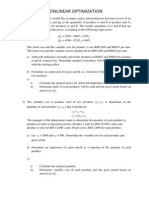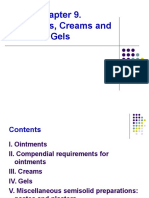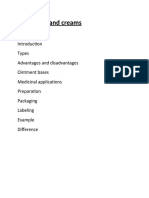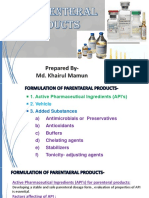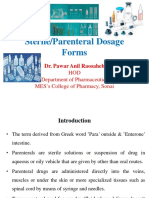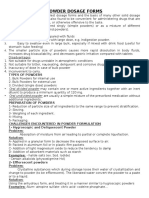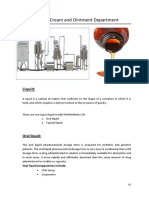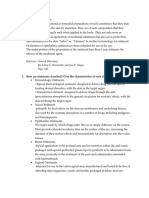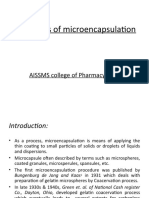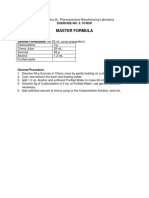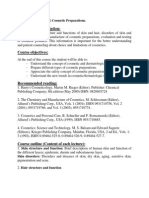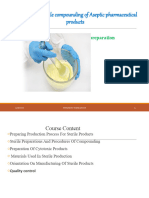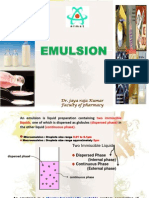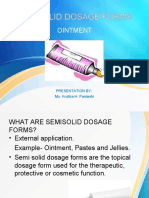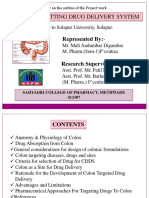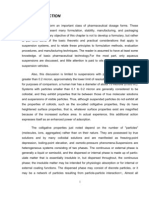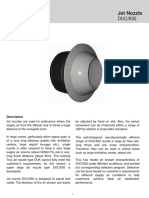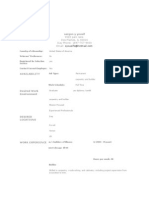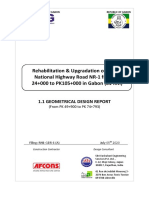Ointment Cream Gel
Ointment Cream Gel
Uploaded by
princeamitCopyright:
Available Formats
Ointment Cream Gel
Ointment Cream Gel
Uploaded by
princeamitCopyright
Available Formats
Share this document
Did you find this document useful?
Is this content inappropriate?
Copyright:
Available Formats
Ointment Cream Gel
Ointment Cream Gel
Uploaded by
princeamitCopyright:
Available Formats
Chapter 10 -OINTMENTS, CREAMS, GELS
INTRODUCTION Ointments, Creams, and Gels TOPICAL APPLICATION to the skin place on the surface of the eye vaginally, nasally, rectally TOPICAL DERMATOLOGICAL designed to deliver drug into the skin dermal disorders (SKIN AS TARGET ORGAN) TRANSDERMAL designed to deliver drug through skin (percutaneous absorption) general circulation SKIN NOT BEING THE TARGET ORGAN NOTE: SYSTEMIC ABSORPTION always considered OINTMENTS Unguents are semisolid preparations for external application of such consistency that they maybe readily applied to the skin with or without inunction (rubbing) Ointments should be of such composition that they soften but not necessarily melt when applied to the body. General Uses Of Ointments 1. Acts as protective or protectant - serve as physical barrier to environment 2. Acts as emollient - softens skin and makes it pliable 3. Carrier of medicament - vehicle Types Of Ointments 1. Medicated - those with medicaments for treatments of cutaneous (skin diseases). Examples: Sulfur Ointment, Zinc Oxide Ointment and Compound Resorcinol 2. Non-medicated - also referred to as ointment bases and use as such for their emollient or lubricating effect or use as vehicles in medicated ointments. Example: White Ointment The USP and NF Classify Ointment Bases into Four General Groups a. Hydrocarbon bases or Oleaginous bases b. Absorption bases c. Water removable bases or Emulsion Ointment bases d. Water soluble bases Factors of selecting ointment bases a.Physicochemical properties of the medicaments as stability in the base or influence on consistency b. Patients conditions as to the desired release rate of the drug from the base c. Intended site of application ability of occlusion of moisture from the skin by the base d. Characteristics of the various vehicles available use the one which provided the majority of essential attributes Types of bases 1. HYDROCARBON BASES are water-free, and aqueous preparations may only be incorporated into them in small amounts and then with difficulty USES: HC are use mainly for their emollient effect and not intended for penetration into the skin. They aredifficult to wash off. They do not dry out or change noticeably upon aging. Characteristics a. Retained on the skin for prolong period of time b. Do not permit the escape of moisture to the skin to the atmosphere c. Difficult to wash as such they acts as occlusive dressing
d. They do not change noticeably upon aging e. Insoluble in water f. Not water-washable g. Anhydrous h. Will not absorb water i. Emollient j. Occlusive k. Greasy l. Nonirritating m. Inexpensive, non reactive Sources Of Hydrocarbon Bases a. Vegetable Oil - Mineral oil b. Animal Fat - Oleic oil c. HC from Petrolatum 3 Forms of HC a. Liquid hydrocarbon - Mineral oil b. Semi-solid HC petrolatum Vaseline c. Solid HC - Paraffin Examples a. White Petrolatum b. White Ointment c. Vegetable shortening d. Vaseline Examples Of Hydrocarbon Bases >Petrolatum, NF - mixture of semisolid HC obtained from petroleum Properties: An unctous mass, color yellowish to light amber, melts between 380C -600C Synonyms: Yellow petrolatum, Petroleum jelly Commercial Product: Vaseline >White Petrolatum, USP - is petrolatum that has been decolorized Uses: diaper rash, dry skin Synonym: White Petroleum Jelly Commercial Product: White Vaseline >Yellow Ointment - Each 100 g contains 5 g yellow wax and 95 g of petroleum. Yellow wax is purified wax obtained from honeycomb of the bee (Apis mellifera) Synonym: Simple Ointment >White Ointment, USP - 100 g contains 5% of white wax (bleached purified beeswax) and 95% white petrolatum >Paraffin, NF - is a purified mixture of solid HC obtained from petroleum Characteristics: colorless or white, more or less translucent mass that may be used to harden or stiffen oleaginous semisolid ointment bases. >Mineral Oil, USP - is a mixture of liquid HC obtained from petroleum. Useful in levigating of substances insoluble in it in the preparation of ointment base e.g. Salicylic acid, Zinc oxide Synonym: Liquid Petrolatum >Olive Oil, USP - from crushed olives- also called sweet oil 2. OFFICIAL ABSORPTION BASES 2 TYPES >Those that permit the incorporation of aqueous solutions resulting in the formation of water-in-oil emulsion. (Anhydrous absorption bases) i. Insoluble in water ii. Not water washable iii. Anhydrous iv. Can absorb water v. Emollient vi. Occlusive
vii. Greasy Examples: Hydrophilic Petrolatum and Anhydrous Lanolin >Those that are already water-in-oil emulsion (emulsion base) that permits the incorporation of small additional quantities of aqueous solution Characteristics a. Insoluble in water b. Not water washable c. Contains water (limited) d. Emollient e. Occlusive f. Greasy Examples: Lanolin and Cold cream; water soluble drugs: Gentamycin Sulfate Characteristics a. Not easily removed from skin with water washing b. May possess some power of penetration into the deepest layers of the skin c. Used for endodermic ointment USES >As emollient but do not provide the degree of occlusion >Incorporates aqueous solutions into oleaginous bases EXAMPLES OF ABSORPTION BASES a. Hydrophilic Petrolatum, USP - composed of cholesterol, stearyl alcohol, white wax and white petrolatum Example: Aquaphor b. Anhydrous Lanolin, USP - may contain NMT 0.25% water. Characteristics: It is insoluble in water but mixes without separation with about 2x its weight in water. The incorporation of water results in the formation of a W/O emulsion Synonym: Refined Wool Fat c. Lanolin, USP - is a semisolid fat like substance obtained from the wool of sheep (Ovis aries) Characteristics: It is a W/O emulsion that contains between 25 to 30% water. Additional water may be incorporated into lanolin by mixing Synonym: Hydrous Wool Fat d. Cold Cream, USP - is a semi solid white W/O emulsion prepared with cetyl esters wax, white wax, mineral oil, sodium borate, and purified water Examples: Eucerin cream - is a W/O emulsion of petrolatum, mineral oil, mineral wax, wool wax, alcohol and bronopol. Cold cream - emollient and base. 3. WATER REMOVABLE BASE Are oil-in-water emulsion that are capable of being washed from skin or clothing with water. For this reason, they are frequently referred to as water- washable ointment base. WATER REMOVABLE BASES Characteristics a. Resemble creams in their appearance b. May be diluted with water or with aqueous solution c. From therapeutic viewpoint, no ability to absorb serous discharge in dermatologic conditions d. Certain medicinal agents may be better absorbed in the skin e. Insoluble in water f. Water washable
g. Contains water h. Can absorb water i. Non-occlusive j. Non-greasy Example: Hydrophilic Ointment, USP - is water loving. It contains sodium lauryl sulfate as the emulsifying agent, with stearyl alcohol and white petrolatum representing the oleaginous phase of emulsion and propylene glycol and water representing the aqueous phase. Methyl and Propyl parabens are used as preservatives a. Hydrophilic Ointment b. Vanishing Cream c. Dermabase d. Velvachol e. Unibase USE: employed as water removable vehicle for medicinal substances 4. WATER SOLUBLE BASE Unlike water-removable bases, which contains both water soluble and water insoluble components. Like water-removable bases, however, water soluble bases are water washable and are commonly referred to as greaseless because of the absence of any oleaginous materials Characteristics a. Because they soften greatly with the addition of water, aqueous solutions are not effectively incorporated into these bases. Rather, they are better used for the incorporation of non-aqueous or solid substance. b. These penetrated the skin and better used for absorption of medicament and therefore used for diadermic ointment. c. Water soluble d. Water washable e. May contain water f. Can absorb water (limited) g. Non-occlusive h. Non-greasy i. Lipid-free Example: Polyethylene Glycol Ointment, USP is a combination of 400 g of polyethylene glycol 4000 (solid) and 600 g of polyethylene glycol 400 (liquid) to prepare 1000 g of base. SELECTION OF THE APPROPRIATE BASE 1. The desired release rate of the particular drug substance from the ointment base. 2. The desirability for enhancement by the base of the percutaneous absorption of the drug. 3. The advisability of occlusion of moisture from the skin by the base. 4. The short term and long term stability of the drug in the ointment base 5. The influence, if any, of the drug on the consistency or other features of the ointment base. Preparation of Ointment 1. INCORPORATION The components of the ointment are mixed together by various means until a uniform preparation has been attained. In small scale or in extemporaneous compounding of the Rx, the pharmacist may use 2 means: i. Mixing ingredients in a mortar with pestle until smooth ointment produced ii. Use a spatula and an ointment slab (a large glass or porcelain plate) to rub the ingredients together (spatulation) a. Incorporation Of Solid
In preparing ointment by spatulation, the pharmacist works the ointment with a stainless steel spatula but if the components react with metal (such as iodine, tannins, mercuric salts) the hard rubber is used 1. The ointment base is placed on one side of the working surface. 2. The powdered components (previously reduced into fine powders) are placed on the other side. 3. Then a portion of the powder is mixed with a portion of the base until uniform. 4. Repeat until all portions of the product and based are combine. 5. The portions of prepared ointment are then combined and thorough blended by continuous movement of the spatula. b. Incorporation Of Liquids Liquid substances or solutions of drugs are added to an ointment only after due consideration of the ointment nature. An aqueous solution would be added with difficulty to the oleaginous ointment, except in very small amount. However, water absorbable hydrophilic ointment bases would be quite suitable for the absorption and incorporation of the aqueous solution. In case of of hydrophobic base and an aqueous solution is to be added, a portion of the hydrophobic base is replaced by a hydrophilic base. 2. FUSION METHOD By this method, all or some of the components of an ointment are combined by melting together and cooled with constant stirring until congeal. Those components not melted are generally added to the congealing mixture as it is cooled and stirred. The heat labile substances and volatile constituents are added last when temperature is low enough not to cause decomposition. Packaging and Storage Of Ointments Semisolid pharmaceuticals frequently either in jars or in tubes. The jars may be made of glass, uncolored, colored green, amber or blue or opaque and porcelain white. Plastic jars are used in limited extent. The tubes are made of tin or plastic. These are called collapsible tube. TESTS REQUIREMENTS FOR OINTMENTS 1. Microbial Content Meet acceptable standard for microbial Must contain antimicrobial preservatives Preservatives: methylparaben, propyl paraben, phenols, benzoic acid, sorbic, quaternary ammonium salts Example: Betamethasone Valerate Ointment must be absence of Staphylococcus aureus and Pseudomonas aeriginosa 2. Minimum Fill Test net weight and volume 3. Packaging, Storage, and Labeling a. metal, plastic tubes, jar b. Well close containers, light sensitive, light resistant c. Labeling- type of base used (water soluble or insoluble) 4. Additional Standards a. Examine the viscosity b. Vitro drug release to ensure within lot and lot-to- lot uniformity Tubes May Be Filled By The Following Steps
1. The prepared ointment is rolled into a cylinder shape of a piece of parchment paper; the diameter is smaller than that of the tube. 2. With cap of the tube off to permit escape of air, the cylinder of ointment with the paper is inserted into the open bottom of the tube 3. The piece of paper covering the ointments is grasped in one hand, the other hand forces a heavy spatula down on the extreme end of the tube, collapsing it and retaining the ointment while the paper is slowly pulled from the tube. About one half (1/2) inch of the bottom is then flattened with the spatula. 4. About 1/8 folds are made from the flattened end of the tube and sealed by pliers or sealing clip on foot operated crimper machine. Note: Ointments made by fusion may be poured directly into the tubes. Stored at temperatures below 30oC to prevent softening.
CREAMS Are solid emulsion containing suspensions or solutions of medicinal agents for external application. Creams of the O/W type include foundation creams; hand creams; shaving creams; and vanishing creams. Creams of W/O type include cold creams; emollient creams Product referred to as creams may not actually conform to the above definition. Many products that are creamy in appearance but do not have an emulsion-type base are commonly called creams Example: Bacitracin (Anti-bacterial) Nystatin- Mycostatin cream (Antifungal) Tretinoin- Retin A Cream (Antiacne) Crotamiton- Eurax cream (Scabicides) TIOCONAZOL TROSYD Luorouracil-Efudex Cream (Antineoplastic)
Examples of Ointments and Creams 13. Hydroquinone cream - Eldopaque cream (Depigmenting Agents) 14. Lindane - Kwell cream (Scabicides) 15. Dioxybenzone - Solvar cream and Oxybenzone (Sunscreening Agent) Examples of Ophthalmic Ointment Ointment Chloramphenicol Commercial Product Chloromycetin Ophthalmic Category Antibacterial
Dexamethazone Na adrenocortical steroid Gentamicin sulfate Isoflurophate Polymixin B-Bacitracin Polymixin B Bacitracin Sulfacetamide Na Tobrex Vidarabine
Decadrone Phosphate
Anti-inflammatory phosphate
Garamycin Floropryl Sterile Polysporin Neosporin Sodium sulamyd Antibacterial Vira A
Antibactrial Cholinasterase inhibitor Antimocrobial Antimicrobial neomycin Antibacterial Tobramycin Antiviral
GELS Are semisolid systems consisting of either suspensions made up of small inorganic particles or large organic molecules in an liquid vehicle rendered jelly like by the addition of a GELLING AGENT. Sometimes called JELLIES Examples of Gelling Agents 1. Carbomers 910; 934; 934P; 940; 941;1342 2. Carboxymethylcellulose; natural gums *0.5 to 2.0% concentration in water Adrenocortical Steroids 1. Betamethasone Valerate - Valisone cream and ointment 2. Fluocinolone Acetonide - Synalar cream and ointment 3. Hydrocortisone Acetate - Cortaid cream and ointment 4. Triamcinolone Acetonine - Aristocort A cream and ointment 5. Tretinoin - Retin A cream and ointment (Antiacne Drug) 6. Nitroglycerin - Nitro-Bid ointment (Antianginal drug) 7. Antibacterial/Anti-infectives a. Bacitracin - Baciguent ointment b. Gentamicin Sulfate - Garamycin cream & ointment c. Nystatin - Mycostatin cream and ointment d. Mupirocin - Bactroban ointment 8. Antifungals a. Nystatin - Mycostatin cream and ointment b. Miconazole Nitrate - Monistat-Derm cream c. Naftidine HCl - Naftin cream d. Tolnaftate - Tinactin cream 9. Luorouracil - Efudex cream (Antineoplastic) 10. Crotamiton - Eurax cream (Scabicides) 11. Anesthetics a. Benzocaine - various b. Dibucaine - Nupercainal cream and ointment 12. Zinc oxide various (Astringent/Protectant) Classes of Gel
1. 2 phase systems - separation between the insoluble matter and liquid vehicle is observed. This type contains inorganic materials Example: Al(OH)3 Gel 2. Single phase gel - consist of organic macromolecules uniformly distributed throughout the liquid where no apparent boundary is seen Example: Na CMC and Tragacanth Gel 3. Continuous phase - commonly aqueous where alcohol and gels may be use as continuous phase Example: Mineral oil + polyethylene resin = oleaginous ointment base Characteristics of Gels 1. Gels may be thicken on standing, forming a THIXOTROPE, and must be shaken before use to liquefy the gel and enable pouring Aluminum Hydroxide Gel 2. Because of high degree of attraction between the dispersed phase and water medium, the gels remain fairly uniform upon standing and does not readily settle Example of Gel 1. Clobetasol propionate- Termovate Gel (Dermatologic: Antipruritic) 2. Acetic acid- Aci-jel (Vaginal: Restoration and maintenance of acidity) 3. Progesterone- Crinone Gel (Vaginal: Bioadhesive gel; Progesterone supplement and replacement) Uses of Gels 1. Lubricant for catheters 2. Bases for patch testing 3. NaCl gel for electrocardiography 4. Floucinonide Gel for anti- inflammatory corticosteriod 5. Na Fluoride & Phosphoric acid gel dental care prophylactic 6. Tretionoin Gel for treatment of acne 7. Prostaglandin Gel intravaginal Gels and Magmas are considered colloidal dispersion since they contain particles of colloidal dimensions APPROPRIATE NAMES (COLLOIDAL DISPERSION) SOLS term to designate a dispersion of solid in either a liquid, solid or gas dispersion medium a. Prefix HYDRO water as dispersion medium so called HYDROSOL b. Prefix ALCO alcohol as the dispersion medium so called ALCOSOL c. AEROSOL dispersion of solid or liquid in gaseous phase Preparation of Gels 1. By freshly precipitating the disperse phase upon reacting an inorganic agents, a gelatinous precipitate results Example: Preparation of Al(OH)3 gel is by reacting Al(Cl)3 + Na2CO3 NaHCO3 2. By direct hydrating the inorganic material in water
Al2O3 + H2O Al(OH)3
Examples: Aluminum Hydroxide Gel; Alugel; Amphogel; Ce-lu-gel; Cremalin; Hydroxal; Vanogel; Aluminum Phosphate Gel (Phosphagel) Antacid a. b. c. d. e. f. Examples Of Topical Gels Erythromycin and benzoyl peroxide topical gel - Benzamycin Clindamycin Topical gel - Cleocin T Topical Gel Benzoyl Peroxide Gel - Desquam-X 10 Gel - acne vulgaris Hydroquinone Gel - Solaquin Forte Gel - bleach for hyperpigmented skin Salicylic Acid Gel - Compound W Gel - keratolytic Desoximetasone Gel - Topicort - anti-Inflammatory, antipruritic agent
Active Ingredient Proprietary Gelling agent Route & Use Acetic acid Aci-jel Tragacanth, acacia Vaginal; restoration & maintenance of acidity Becaplermin Regranex gel Na CMC Dermatologic Benzoyl peroxide Desquam-X gel Carbomer 940 Acne vulgaris Clindamycin Cleocin T gel Carbomer 934 Antipruritic Cyanocobalamin Nascobal Methylcellulose Nasal: hematologic Desoximetasone Topicort gel Carbomer 940 Anti-inflammatory; antipruritic Metronidazole Metro-gel Carbomer 934P
Vaginal-bacterial Progesteron Crinone gel Carbomer 934P Progesterone supplement Tretinoin Retin-A Hydroxypropyl cellulose Acne vulgaris
TRANSDERMAL PREPARATIONS Ointments, creams, gels designed to deliver a drug systematically by addition of PENETRATION ENHANCERS to the topical vehicle Examples of Penetration Enhancers o Dimethyl sulfoxide (DMSO), ethanol, propylene glycol, glycerin, polyethylene glycol, urea, dimethyl acetamide, sodium lauryl sulfate, poloxamers, Spans, Tweens, lecithin, and terpenes o Example: PLURONIC lecithin organogel (PLO) Pluronic (Poloxamer) F127 gel (usually 20% to 30% concentration) PASTE Dermatologic paste are ointment like preparations employed in practice of dermatology Usually stiffer, less greasy and more absorptive than ointments such as starch, ZnO, CaCO3 , and talc in the base Characteristics a. Stiffness and impenetrability, not suited for hairy parts of the body b. Absorbs serous secretions and are preferred for acute lesions having a tendency to ooze c. Are less penetrating than ointment d. Are less macerating than ointment Types a. Dermatologic Paste b. Paste for injection Examples of Paste a. Zinc Oxide Paste with acid - Lassars Paste - Salicylic acid 20 g; and ZnO paste q.s. to make 1000g b. Zinc Oxide Paste - ZnO 250 g; Starch 250 g ; White petrolatum 500 g to make 1000 g c. Triamicinolone Acetonide Dental Paste PLASTERS Substances intended for external application, made of such materials and consistency as to adhere to the skin and thereby attach as dressing Purpose: a. To afford protection and mechanical support b. c. To furnish an occlusive macerating action To bring medication into close contact with surface of skin
General information ulcers because of its ability to form pressure bandage known as gelatin boot. Example of Plasters a. Adhesive plaster consisting of vinyl resin, plasticizers, and chemical additives b. Modern Plasters are practically all machine made and are available in colors such as flesh, striped, and others c. Medicated plasters - Salicylic Acid Plaster, Salonpas d. BACK PLASTERS i. are made of heavy cotton or wool and cotton backing to provide warmth and support. ii. They are usually used for backache, sore shoulders, sore arms, and other muscular
Medicinal substance 400g Purified water
100g Gelatin 350g to make about
150g Glycerin 1000g
DRESSINGS Dressings are external application resembling ointments in consistency, but remaining semisolid at body temperature, they 0 0
CERATES aches iii. The active constituents of back plaster is OLEORESINS OF CAPSICUM iv. EXAMPLES: Chilli Plaster; Hot Salonpas liquefy at 50 C and remain pliable in thin films below 28 C. Classes Of Dressings a. Primary wound dressing or now as wet dressing b. Absorbents - surgical cotton and gauze c. Bandages d. Adhesive tapes Examples of Dressings Are unctuous preparations of such consistency that may be easily spread at ordinary temperature upon muslin cloth or similar material with spatula yet not soft to liquefy and run when applied to the skin Contents: oil, hard petrolatum and beeswax Examples: Cantharides cerates; Rosin cerate; Camphor cerate; Cerate of lead acetate; Compound Rosin Cerate CATAPLASM
Are viscous preparation intended for warm, external application to a body for purpose of reducing inflammation Are soft semisolid, external applications which either stimulate a body surface or alleviate an inflamed area by supplying medication substance in the presence of heat and mixture. Example: Numotizine CEMENTS Are dental preparation employed primarily as temporary protective coverings for exposed pulps; also for holding medicinal agents in tooth cavities and re-basing of dentures. Methods of preparation and Ingredients a. Mixing a powder consisting of ZnO, and other metallic salts with a liquid consisting of either eugenol or clove oil mixed with a bland oil. b. Zinc acetate and other metallic salts accelerate the settling time c. The consistency of the cement may be altered by varying amount of the liquid. GLYCEROGELATINS Are plastic masses intended for topical application and containing gelatin, glycerin, and water and a medicament suitable for application in dermatological practice. ADMINISTRATON OF GLYCEROGELATIN a. Glycerogelatins are melted prior to application, cooled to only slightly above body temperature, and applied to the affected area with a fine brush. After application the glycerogelatins hardens, usually covered with bandage. b. Example: Zinc Gelatin Boot c. Zinc Gelatin is a firm, plastic mass containing 10% zinc oxide in a glycerogelatin base treatment of varicose a. Paraffin dressing, formerly official in the NF VI, was employed as an air-excluding, soft, pliable, analgesic, splint- like covering for surface denuded by burns b. Petrolatum Gauze, USP - is absorbent gauze saturated with white petrolatum. c. Furazone gauze pads-sterile - antibacterial dressings containing nitrofurazone d. Surgical dressing is any material used as covering, protective, or support for a diseased part 1. Adhesive bandage, USP 2. Gauze bandage Packaging Semi Solid Preparations a. Topical dermatologic jars or tubes b. Ophthalmic, nasal, vaginal, rectal tubes c. Ointments ointment jars opaque glass or plastic; some colored green, amber or blue d. Ointment jars about 0.5 ounce to 1 pound e. Jars and tubes must be tested for compatibility and stability f. Ointment tubes aluminum or plastic g. Ophthalmic, rectal, vaginal, aural or nasal packaged with special applicator h. Aluminum tubes coated with epoxy resin, vinyl lacquer to eliminate any interaction with the content i. Plastic tubes High or low density polyethylene (HDPE or LDPE), polypropylene (PP), polyethylene terepththalate (PET), plastics, foil or paper laminate sometimes 10 layers thick j. LDPE soft and resilient, provides good moisture barrier k. HDPE less resilient but provides a superior moisture barrier l. 12. PP has a high level of heat resistant
m. n. o. p. q.
13. PET transparency and high degree of chemical compatibility 14. Multiple dose tubes continuous thread closures 15. Single dose tubes tearaway tip 16. Tubes capacities of 1.5, 2, 3.5, 5,15,30,45,60,120g 17. Ophthalmic ointments- collapsible plastic or aluminum
You might also like
- Operating Manual Extruder MEV4 (Rev1.0)Document156 pagesOperating Manual Extruder MEV4 (Rev1.0)Wing ZenandNo ratings yet
- White Wax 50 G White Petrolatum 950 G To Make 1000 GDocument3 pagesWhite Wax 50 G White Petrolatum 950 G To Make 1000 GRoseanne Legaspi CasayuranNo ratings yet
- Paracetamol Syrup With K 150Document2 pagesParacetamol Syrup With K 150Muhammad Abdullah100% (1)
- Calamine LotionDocument2 pagesCalamine LotionHeba Ali100% (1)
- Water MucilagesDocument11 pagesWater MucilagesP100% (1)
- Introduction To Cosmetic ScienceDocument21 pagesIntroduction To Cosmetic ScienceHarshaNo ratings yet
- Pharmaceutical Dosage FormsDocument10 pagesPharmaceutical Dosage FormsprinceamitNo ratings yet
- S-000-5140-012 - 0 Coordination Procedure PDFDocument15 pagesS-000-5140-012 - 0 Coordination Procedure PDFMahadevan MahalingamNo ratings yet
- TAC Xenta Server - TAC Networks Technical ManualDocument306 pagesTAC Xenta Server - TAC Networks Technical ManualGabor KomuvesNo ratings yet
- Nonlinear ProgrammingDocument2 pagesNonlinear ProgrammingKristen ObrienNo ratings yet
- TM 11-5840-345-34P - Radar - System - AN - FSQ-84 - 1978 PDFDocument58 pagesTM 11-5840-345-34P - Radar - System - AN - FSQ-84 - 1978 PDFWurzel1946No ratings yet
- Ointments, Creams and GelsDocument109 pagesOintments, Creams and Gelsallen reyesNo ratings yet
- Ointments, Creams and GelsDocument109 pagesOintments, Creams and GelsAllyson Carlos100% (1)
- 1) Ointments and Creams .DispensingDocument63 pages1) Ointments and Creams .DispensingMeena Ali100% (1)
- Semi-Solid Dosage Forms: Ointments, Creams, Pastes & GelsDocument35 pagesSemi-Solid Dosage Forms: Ointments, Creams, Pastes & GelsAnaliza Kitongan LantayanNo ratings yet
- Semisolid Dosage Forms - Ointments, Pastes and JelliesDocument46 pagesSemisolid Dosage Forms - Ointments, Pastes and JelliesKhushbooNo ratings yet
- Ointment Dosage Form: Sulaimani Polytechnique University Technical Institute of Sulaimany Pharmacy DepartmentDocument12 pagesOintment Dosage Form: Sulaimani Polytechnique University Technical Institute of Sulaimany Pharmacy DepartmentZanyar Rebwar YasinNo ratings yet
- Ointments and Creams Basics of FormulationDocument4 pagesOintments and Creams Basics of FormulationJai MurugeshNo ratings yet
- Parenteral PPT (Part-2)Document19 pagesParenteral PPT (Part-2)monoj5859No ratings yet
- Topical Dosage FormsDocument19 pagesTopical Dosage FormscseoukienandanNo ratings yet
- Parenteral PPT (Part-4)Document64 pagesParenteral PPT (Part-4)monoj5859No ratings yet
- Batch Manufacturing Formula, Method and Record: Clamprs CorporatedDocument4 pagesBatch Manufacturing Formula, Method and Record: Clamprs CorporatedHannah Jean LemorenasNo ratings yet
- Syrups 1Document90 pagesSyrups 1032 Sarap DeepikaNo ratings yet
- Dispensing of SolutionsDocument72 pagesDispensing of SolutionsSania SyedNo ratings yet
- Ointments, Creams and Gels. PhardoseDocument8 pagesOintments, Creams and Gels. PhardoseKim Manlangit100% (1)
- Sterile Products & ParenteralsDocument41 pagesSterile Products & ParenteralsRonit PoudelNo ratings yet
- Parenteral Dosage Form IntroductionDocument69 pagesParenteral Dosage Form IntroductionVicky AgroNo ratings yet
- Dosage - Chapter 14Document57 pagesDosage - Chapter 14kaukau4ever100% (1)
- Filling Ointment JarsDocument3 pagesFilling Ointment JarsAmit SinghNo ratings yet
- Powder Dosage FormsDocument3 pagesPowder Dosage FormsMukesh TiwariNo ratings yet
- Simple Syrup I.PDocument38 pagesSimple Syrup I.PHimanshi SharmaNo ratings yet
- Liquid, Cream and Ointment DepartmentDocument9 pagesLiquid, Cream and Ointment DepartmentmuizmahmoodNo ratings yet
- OintmentDocument6 pagesOintmentBSNo ratings yet
- Cold Cream USPDocument4 pagesCold Cream USPRon OlegarioNo ratings yet
- Absorbable Dusting PowderDocument3 pagesAbsorbable Dusting PowderRoseanne Legaspi CasayuranNo ratings yet
- Chapter 16 - Reducing and Enlarging Formulas StudentDocument28 pagesChapter 16 - Reducing and Enlarging Formulas StudentKatie Wilson100% (4)
- PARENTRALSDocument117 pagesPARENTRALSkarnam.lahari17No ratings yet
- Paracetamol TabletDocument3 pagesParacetamol TabletamebadhaNo ratings yet
- Parentral ProductsDocument28 pagesParentral ProductsMD ABID ALAM100% (3)
- Preparation and Evaluation of Herbal Cold Cream With Incorporated Curcuma LongaDocument3 pagesPreparation and Evaluation of Herbal Cold Cream With Incorporated Curcuma LongaInternational Journal of Innovative Science and Research TechnologyNo ratings yet
- Formulation and Evaluation of Salicylic Acid Sodium Salicylate Topical Gels Using Peg PolymersDocument5 pagesFormulation and Evaluation of Salicylic Acid Sodium Salicylate Topical Gels Using Peg PolymersInternational Journal of Innovative Science and Research TechnologyNo ratings yet
- Semi Solids FinalDocument27 pagesSemi Solids FinalAubrey Monette Padilla-ItchonNo ratings yet
- Dosage - Chapter 10Document9 pagesDosage - Chapter 10kaukau4everNo ratings yet
- Quality Control of Tablets Lecture 1Document15 pagesQuality Control of Tablets Lecture 1Muhammad AzeemNo ratings yet
- Quality Control Tests For Tablets and CapsulesDocument27 pagesQuality Control Tests For Tablets and Capsulesasksankar7857100% (2)
- Antacid Suspension PDFDocument3 pagesAntacid Suspension PDFvenishetty0% (1)
- Phardose Lab (Prep 6-10)Document3 pagesPhardose Lab (Prep 6-10)Jan Aira Almazan100% (1)
- Methods of Micro EncapsulationDocument54 pagesMethods of Micro Encapsulationanupnakat100% (8)
- Syrup FormulationDocument1 pageSyrup FormulationxylentknightNo ratings yet
- EMULSIONSDocument39 pagesEMULSIONSDanielNo ratings yet
- Deliverable VolumeDocument3 pagesDeliverable VolumePrince MoniNo ratings yet
- CosmeticsDocument4 pagesCosmeticsrandatagNo ratings yet
- Topic 6: Hard and Soft Gelatin CapsulesDocument9 pagesTopic 6: Hard and Soft Gelatin CapsulesKate EvangelistaNo ratings yet
- Small Scale Cpding in AsepticDocument75 pagesSmall Scale Cpding in AseptictegenezewudeNo ratings yet
- 634798775670659161Document41 pages634798775670659161Suvin PsNo ratings yet
- QC Tests For Tablet Dosage FormsDocument8 pagesQC Tests For Tablet Dosage FormsBernadette BoholanoNo ratings yet
- Parenterals Unit IIIDocument117 pagesParenterals Unit IIIKrishna PrasadNo ratings yet
- C-10 Ointment 2Document90 pagesC-10 Ointment 2Mara Angelica100% (1)
- Ointments, Pastes and GelsDocument10 pagesOintments, Pastes and GelsBee100% (1)
- Final HODocument15 pagesFinal HOMoonrich Dayle BallestraNo ratings yet
- Ointment: Presentation By: Ms. Krutika H. PardeshiDocument23 pagesOintment: Presentation By: Ms. Krutika H. PardeshiShumaila QadirNo ratings yet
- 4 - Ointments PDFDocument29 pages4 - Ointments PDFremo s100% (1)
- Unit OintmentDocument39 pagesUnit OintmentEE KMNo ratings yet
- Reporter: Date: Group No.: 2 Rating: Experiment No. 10 Ointments Questions: 1. State The Uses Of: A. OintmentsDocument6 pagesReporter: Date: Group No.: 2 Rating: Experiment No. 10 Ointments Questions: 1. State The Uses Of: A. Ointmentsjanicedeguia1394No ratings yet
- Di Drug Inspector Pharmaceutical Chemistry TNPSC 2019 Exam Paper The PharmapediaDocument36 pagesDi Drug Inspector Pharmaceutical Chemistry TNPSC 2019 Exam Paper The PharmapediaprinceamitNo ratings yet
- E-Rojgar Samachar Patra PDF Hindi - Employment Newspaper This Week PDF Hindi - 12 February 2022 To 18 February 2022Document40 pagesE-Rojgar Samachar Patra PDF Hindi - Employment Newspaper This Week PDF Hindi - 12 February 2022 To 18 February 2022princeamitNo ratings yet
- DWDWQDocument10 pagesDWDWQprinceamitNo ratings yet
- CSCSACSADocument11 pagesCSCSACSAprinceamitNo ratings yet
- Gastroretentive Microballoons: A Novel Approach For Drug DeliveryDocument9 pagesGastroretentive Microballoons: A Novel Approach For Drug DeliveryprinceamitNo ratings yet
- Prevalence of Glaucoma in India: A Review: Ronnie George, Lingam VijayaDocument5 pagesPrevalence of Glaucoma in India: A Review: Ronnie George, Lingam VijayaprinceamitNo ratings yet
- Sustained Release Drug Delivery System Potential: The Pharma InnovationDocument13 pagesSustained Release Drug Delivery System Potential: The Pharma InnovationprinceamitNo ratings yet
- Solid Lipid Nanoparticle: Presented By.. Mr. Wagh Pankaj N. M.Pharm. (II Sem)Document27 pagesSolid Lipid Nanoparticle: Presented By.. Mr. Wagh Pankaj N. M.Pharm. (II Sem)princeamitNo ratings yet
- Dendrimer: Chinchole Pravin SonuDocument24 pagesDendrimer: Chinchole Pravin SonuprinceamitNo ratings yet
- 635975089266247500Document36 pages635975089266247500princeamitNo ratings yet
- Carbonnanotubes Presentation 171118095806Document18 pagesCarbonnanotubes Presentation 171118095806princeamitNo ratings yet
- A Report On Pharmaceutical SuspensionDocument84 pagesA Report On Pharmaceutical Suspension0921py67% (3)
- 635679412632888750Document29 pages635679412632888750princeamitNo ratings yet
- OCLC Vs Open Source AlternativesDocument6 pagesOCLC Vs Open Source AlternativesJason W. Dean100% (2)
- Dec Lab ManualDocument5 pagesDec Lab ManualSam XingxnNo ratings yet
- Arrow Acat 1 Intra Aortic PumpDocument3 pagesArrow Acat 1 Intra Aortic PumpMiguel AngelNo ratings yet
- Abg-00-q0-Mn-002 Wps & PQR Rev. C-AgsDocument26 pagesAbg-00-q0-Mn-002 Wps & PQR Rev. C-AgsAgus SuriptoNo ratings yet
- IYI-Seismic Protection of Structures With Modern Base Isolation Technologies PDFDocument10 pagesIYI-Seismic Protection of Structures With Modern Base Isolation Technologies PDFmelseNo ratings yet
- All Match Up ExcelDocument49 pagesAll Match Up ExcellietcshodNo ratings yet
- DUC630 Jet Nozzle-2Document4 pagesDUC630 Jet Nozzle-2Julio AlceramNo ratings yet
- W A U K E S H A: 100 FORM 6302 First EditionDocument2 pagesW A U K E S H A: 100 FORM 6302 First Editiondiego yecid millan mendozaNo ratings yet
- p4 Electric Circuits Mark SchemeDocument28 pagesp4 Electric Circuits Mark SchemeRutna Kothari BehalNo ratings yet
- Indesign Ebooks Tutorial: Reference ManualDocument6 pagesIndesign Ebooks Tutorial: Reference ManualMurliadi PalhamNo ratings yet
- GA 250 VSD - 125 Psi - Water Cooled - 2015 Rev 0Document1 pageGA 250 VSD - 125 Psi - Water Cooled - 2015 Rev 0Vi Na Ridho ChabieNo ratings yet
- Sargon Resuma 2Document3 pagesSargon Resuma 2Nicholas LeNo ratings yet
- Pfsense VPN Router & GreenBow IPSec VPN Client Software ConfigurationDocument14 pagesPfsense VPN Router & GreenBow IPSec VPN Client Software ConfigurationgreenbowNo ratings yet
- Asida Distance Relay Adr-239aDocument27 pagesAsida Distance Relay Adr-239aRitesh JaiswalNo ratings yet
- Service Manual: RefrigeratorDocument18 pagesService Manual: RefrigeratorLeonardo Alejandro OrdoñezNo ratings yet
- Emergency Breakdown at 132kv Grid Station Bhagwal and Restoration of Power SupplyDocument25 pagesEmergency Breakdown at 132kv Grid Station Bhagwal and Restoration of Power SupplyMehtab AhmedNo ratings yet
- ATC 10/1/1998 ATC Level July 2007Document21 pagesATC 10/1/1998 ATC Level July 2007natcaalbNo ratings yet
- CP II Lab Manual For EngineersDocument93 pagesCP II Lab Manual For EngineersVenkatesh ShankarNo ratings yet
- Smart Grid in IndiaDocument17 pagesSmart Grid in Indiatejomayi100% (1)
- Brick Work QuotationDocument4 pagesBrick Work QuotationseetharamchNo ratings yet
- Personnel Work Platform Safety: Cover StoryDocument3 pagesPersonnel Work Platform Safety: Cover StoryLalbin BabuNo ratings yet
- Geometric Design Report PK49.9 - PK74.9 en Revised 20th July 2021Document91 pagesGeometric Design Report PK49.9 - PK74.9 en Revised 20th July 2021Adrian FrantescuNo ratings yet
- Hartalega Corporate Social Responsibility (The Edge Billion Dollar Club) FINALDocument5 pagesHartalega Corporate Social Responsibility (The Edge Billion Dollar Club) FINALPiyu MahatmaNo ratings yet
- Measuring Tools: Supplier Name: AddressDocument50 pagesMeasuring Tools: Supplier Name: Addressgeetha raniNo ratings yet
- Lab Reports Requirements Gr. 9Document2 pagesLab Reports Requirements Gr. 9aniedorf100% (1)









